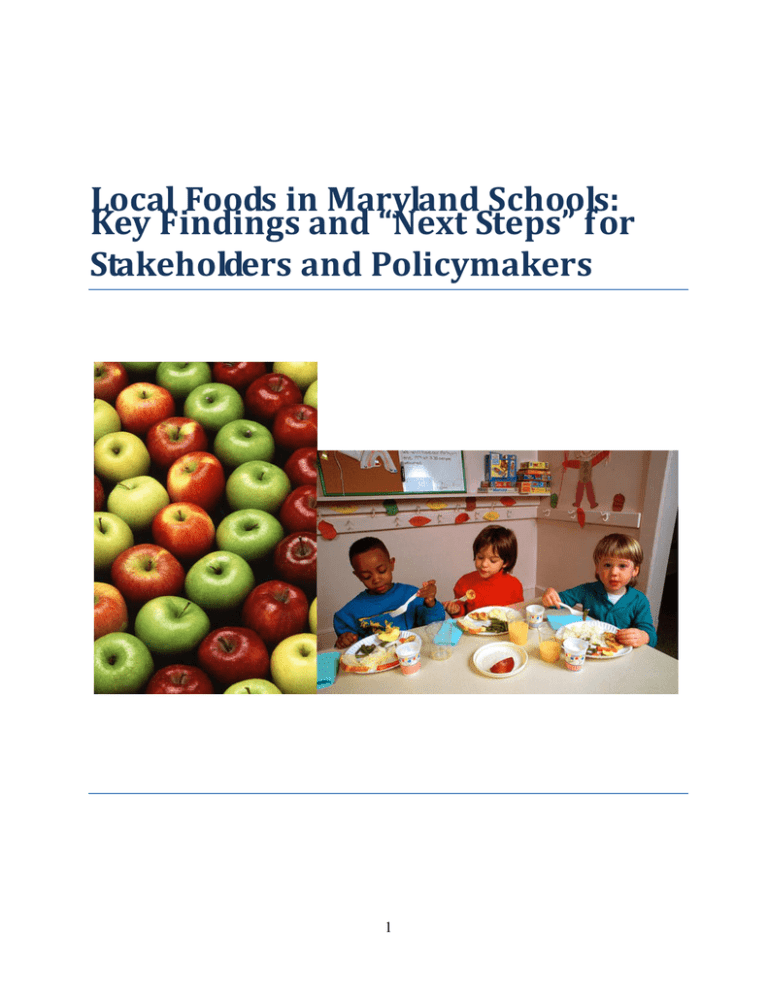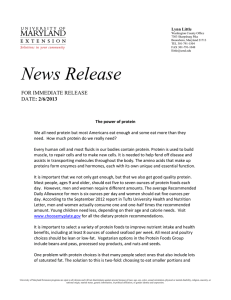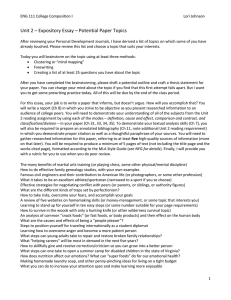Local Foods in Maryland Schools: Key Findings and “Next Steps” for Stakeholders and Policymakers
advertisement

Local Foods in Maryland Schools: Key Findings and “Next Steps” for Stakeholders and Policymakers 1 Executive Summary From 2009 to 2010, a group of researchers and Agricultural Extension specialists examined the supply chain for local foods in Maryland school meals, and investigated the barriers and opportunities for increasing local foods in schools. Interviews and surveys were administered with stakeholders from the entire supply chain, including farmers, distributors, food service directors, and school principals. For the purposes of this report, “local” food is defined as food grown in Maryland and adjacent states. This Executive Summary has two components: 1. Key Findings from a series of one‐on‐one interviews with school food distributors and school food service buyers. 2. Policy Recommendations for state, municipal, and educational policy makers to further develop the positive impacts of the Jane Lawton Farm to School Act. For more detailed information related to this research project, including “How‐To” Mini‐ Guides outlining potential “next steps” for stakeholders interested in increasing local food in Maryland schools, survey results and statistical analysis, please visit http://mdagnrpolicy.arec.umd.edu/ and select “Local Foods.” Contact information for research team members can be found at the end of this report. Key Findings Sixteen in‐depth interviews were conducted in the making of this report. Two were with food distributors who serve public school districts, seven were held with public school food service district directors, and seven were held with private school food service directors. Several key themes emerged over the course of these interviews. They are outlined below. Interest in Local Foods is High First, all of the school food buyers interviewed expressed a moderate to strong degree of interest in bringing local foods into their schools. Those interviewed were selected because they had expressed interest through a separate survey performed though this project. Most interviewed also expressed a belief that local foods in schools have a positive impact on the children, teaching them that their food comes from farmers rather than from the 2 supermarket. There was no clear difference in stated interest between public and private school buyers. Experience with the Jane Lawton Farm­To­School Act is Varied Most public school food service directors generally support the intentions of the Jane Lawton Farm to School Act, but the majority is not interested in seeing a mandate for it to expand. By and large, public school food buyers are wary of any additional work due to the staffing and budget constraints they face. The actions that the public schools take around this legislation are quite varied. Some schools districts have had frustrating experiences and have kept their programs quite limited (e.g., local apples procured once a year for “Home Grown Lunch Week”). Others have made multiple new connections and have been creative and expansive in terms of program implementation and curriculum impact. The degree to which the buyer is flexible about his or her product requirements seems to play an important role. For example, some will not accept fruit of different sizes. Others are fine with this and simply separate out the larger sized fruits for the older children and so on. Likewise, the degree of willingness to allow the children to try out fresh, whole foods in the cafeteria context seems to be important. An example of this is that some buyers stated that they would not consider serving whole peaches to students, as they assumed they would be too messy. Other schools stated that they serve whole peaches to students in all grades, and have been pleased with the results. Countywide Local Food Planning Efforts Are a Key Factor in Success Another area that came up frequently for public school district food buyers was the need for assistance with locating local producers interested in selling to the schools. A factor in success or failure of a local foods buying effort was the ability of the school food buyer to develop a coalition of professionals in the county who are able and willing to assist in locating farms and developing connections for the school. Most frequently mentioned stakeholders were county University of Maryland Extension Educators and county Agricultural Coordinators. In the same vein, almost all school food buyers indicated a desire to learn about what their colleagues were doing in terms of farm to school efforts. Those that had experienced the most difficulty implementing the Jane Lawton Farm to School Act guidelines were the most avid to learn from more successful county school food buyers. They most often mentioned a desire for a statewide meeting where information could be shared and best practices presented. 3 Procurement Contract Practices Influence Usage of Local Foods Most schools use a form of procurement contract to buy food. Some schools – particularly public schools ‐‐ indicated an interest in learning more about integrating local food preferences into their existing procurement contracts for produce. Several had already done this, either by developing their own or by finding and using an existing template. Private schools that contract out their food service to private companies rely on company staff to set procurement practices. Company staff members do not feel a personal interest in altering corporate procurement practices with distributors. These staff stated that if a lot of the company’s clients expressed a strong interest in having more local food, then a change in corporate policy could result. The independently run private schools food service directors interviewed were mildly interested in altering procurement contracts with distributors to favor local foods, but were more likely to actually make individual direct relationships with producers outside of pre‐set distributor procurement contracts. A Major Obstacles to Progress: Time and Cost Time (including staff time) was most frequently mentioned by interviewees as a barrier to bringing in more local foods. Buyers feel they do not have enough time or staff to take local foods “to the next level” through better understanding their local food infrastructure, building their local food stakeholder coalition group, and researching what their colleagues have done so they don’t have to reinvent the wheel, despite their expressed interest in doing so. Cost limitations were also mentioned frequently by public school buyers. Those interviewed had varying experience regarding the relative price of local foods. Several found that local foods were cheaper than the same foods purchase through their regular distributors, particularly in‐season local fruits and vegetables. Others stated that they paid more for local. This was especially true for dairy, meat and processed foods such as ice cream and cheese. Another Major Obstacle to Progress: Limited Local Food Distribution and Aggregation Infrastructure Most of those interviewed talked about the relative logistical difficulty of purchasing local foods directly from producers. Except for independently run private school food service directors, those interviewed preferred purchasing food from a distributor, and strongly favored getting local food through either a traditional food distributor or a local food aggregator/distributor. Amish and Mennonite produce auctions provide one example of how local food aggregator/distributors work. 4 A need for electronic ordering was mentioned by some interviewees, most frequently by the private school buyers who were staff of food service companies. The private schools were also more likely to bring up issues related to producer insurance. Two public school district buyers interviewed used local aggregation/distribution sites (produce auction houses) to purchase local foods. Both had positive experiences. However these facilities are not established in all counties throughout the state. The lack of well developed local food aggregation/distribution infrastructure in the state presents a barrier to increasing local foods in Maryland schools. Policy Recommendations 1. Recommend clauses specifying local food in sales contracts between Maryland public school districts and the U.S. Department of Defense’s produce procurement program. Direct state program coordinators to provide central coordination of the purchase and distribution of local produce for the program. (See page 7 in full report at http://mdagnrpolicy.arec.umd.edu/ and select “Local Foods”.) 2. Recommend that school districts develop county wide “Farm‐to‐School Action Teams” and create “County Farm‐to‐School Action Plans.” Recommend that these plans identify resources, procurement policies, producers, and processes for increasing the amount of local food provided to students in their school districts. Provide centralized statewide support for this process including networking and information sharing for school food service directors. (See page 8 in full report at http://mdagnrpolicy.arec.umd.edu/ and select “Local Foods”) Support private schools in developing similar networks. 3. Recommend that the Maryland State Department of Education and the Maryland Department of Agriculture incorporate food, nutrition, gardening, and farm‐to‐school materials and school‐to‐farm educational experiences into the state’s core curriculum. Recommend that school districts integrate these educational components into their curricula, and support teaching staff in doing so. (See page 10 in full report at http://mdagnrpolicy.arec.umd.edu/ and select “Local Foods”) 5 About the Research Team Dr. James Hanson, Project Director and Extension Specialist, University of Maryland’s Department of Agricultural & Resource Economics, jhanson@arec.umd.edu Dr. Carolyn Dimitri, Visiting Professor with the Department of Nutrition, Food Studies, and Public Health, New York University (carolyn.dimitri@nyu.edu). [Research conducted while a Senior Economist, USDA, Economic Research Service]. Lydia Oberholtzer, Senior Researcher, Pennsylvania State University (office in Maryland); lso3@psu.edu Nessa Richman, Consultant, marketing and food systems (Maryland), nessa.richman@gmail.com Jack Gurley, Farmer advisory ‐‐ operator of Calvert’s Gift Farm and President of Future Harvest—A Chesapeake Alliance for Sustainable Agriculture; giftcal@aol.com Dr. Gerald Brust, IPM Vegetable Specialist with the University of Maryland Cooperative Extension; jbrust@umd.edu Report Author: Nessa Richman September, 2010 COLLEGE OF AGRICULTURE AND NATURAL RESOURCES Department of Agricultural and Resource Economics 2200 Symons Hall College Park, Maryland 20742‐5535 Telephone: 301.405.1293; Fax: 301.314.9091 Funding for this project was provided by the Northeast Center for Risk Management Education and USDA National Institute of Food and Agriculture (Award Number 2007‐49200‐03888) 6




